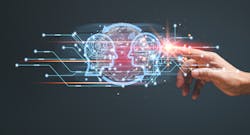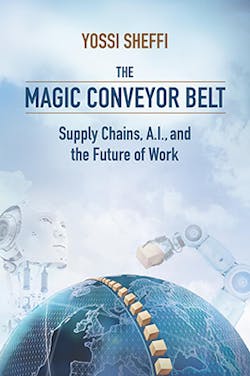Turning the Threat of Automation Into Opportunity
The growing influence of artificial intelligence (AI) is stoking fears that AI will eliminate the need for human workers in most occupations—including highly skilled professions such as engineering.
While these fears are justified in several areas of employment, history shows that technological revolutions mainly augment the tasks of workers and in the aggregate, actually generate more jobs than they eradicate. Moreover, the flexibility of human workers will play a critically important role in automated workplaces of the future. Let’s explore some arguments for such a future.1
New Jobs for Old
Doomsday predictions of people being rendered redundant by machines in the workplace are by no means new. Beginning in the mid-18th century, industrial revolutions driven by technological innovation have fostered job fears, labor unrest, and violent clashes. And in many cases, skilled workers were at the forefront of these movements as machines deskilled their tasks.
For example, the Luddites were a secret organization formed in 19th-century England to combat the advance of mechanical looms in the textile industry. This radical faction destroyed machines and engaged in violent clashes to stop what they saw as widespread job losses and the devaluation of their skills.
While tech-driven industrial revolutions do purge numerous jobs, they also create efficiencies and innovative production methods that generate new employment opportunities.
“People are more adaptable than robots when faced with unstructured conditions and environments. Robotic software systems are built and optimized for specific tasks or domains.”
For example, despite the introduction of ATMs, the number of tellers in the US increased from about 300,000 in 1970 to 600,000 in 2010. As it turned out, because ATMs enabled bank branches to operate with fewer tellers, banks opened more branches, creating many more jobs in the process. But the main impact of transformative new technologies is not creating jobs in existing industries but creating entire industries and hence new categories of jobs.
Consider, for example, the rise of containerization. When American entrepreneur Malcolm McLean loaded 58 trailer bodies onto a ship in 1956, he started a shipping revolution that changed the shape of global trade. Using standard containers to ship cargo around the world vastly increased the efficiency of supply chains. It also eliminated countless jobs associated with the manual loading and unloading of cargo. However, new types of jobs—many in IT and engineering-related occupations—emerged over subsequent decades because the containers must be designed and manufactured, transported across modes, tracked, and maintained. Moreover, containerization has opened new ways to manage supply chains, creating opportunities in related fields such as data analytics and demand forecasting. These changes are still in evidence today.
Transformative change can also generate jobs in other industries. Containerization led to an increase in global trade volumes, an important factor in the growth of international tourism and increased employment in the hospitality industry worldwide.
The Value of Human Flexibility
But the tendency for tech-driven change to create new employment opportunities is not the only reason why human professionals will continue to be a key resource in the workplace. Another reason is that human flexibility will be part of the employment landscape of the future. Below are six examples of the flexibility that humans will bring to future workplaces.
1. Real-World Experience
A lifetime of experience in the physical world allows people to detect changes or discrepancies between normal and abnormal situations. For example, during the financial crisis of 2008, companies worried about the financial health of their suppliers. Many companies asked for economic data from suppliers, but these numbers could be manipulated and only provided a lagging, infrequently updated view of conditions at the supplier. To augment the data, companies sent people to spot-check critical suppliers’ production of parts or materials on behalf of the company.
2. A Moral Perspective
Many work tasks involve value judgments and subjective elements based on the system designer’s or manager’s preferences. However, objectives, moral understandings, and preferences change over time. While machines may be able, if appropriately trained, to sift through large amounts of data and present options for actions, people will have to make the ultimate decisions in cases where the implications matter. This is especially true when the context changes and decisions must be made in a different environment. For example, when prioritizing the response to a disaster, should preference be given to customers, employees, suppliers, shareholders, or the community? The real answer is “it depends” on the nature of the event and the context, which are difficult to program or train a model.
3. Adaptability and Coordination
People are more adaptable than robots when faced with unstructured conditions and environments. Robotic software systems are built and optimized for specific tasks or domains. However, change (disruptions, new knowledge, new products, competitors’ actions, economic cycles, etc.) can render the machine’s appropriateness moot, requiring a person to take over the task. Also, social networks are adept at creating new corporate organizational structures to manage change. This has happened in response to numerous disruptions over recent years, such as the 2011 earthquake in Japan and the COVID-19 pandemic.
4. Built-in Creative Drive
Change that requires adaptation is built into many consumer and technology supply chains, such as fast fashion. These fast-moving supply chains search ceaselessly for differentiation that can spur demand for any new product or service. People, not machines, are part of a cultural milieu that stimulates creativity. Also, humans understand the vagaries of everyday life, and this hands-on experience creates possibilities for new products and services.
5. Empathy and Communication
While a growing number of AI applications are used in health care, computers cannot show the empathy required of a nurse while treating a patient. Likewise, a machine cannot replace the smile of a service worker, such as a cashier in a local supermarket. Similarly, procurement contract negotiations cannot take place without both sides understanding each other, developing rapport, and appreciating each other’s points of view. Even though algorithms that mimic these qualities are becoming increasingly sophisticated, it’s difficult to imagine absolute acceptance of machine-generated, simulated emotions and empathy.
6. Nuanced Risk Management
While rules can be programmed based on different contexts, the most appropriate choice in a situation that requires a company to select a way forward may differ from the one suggested by the rules. For example, if the company suspects that a recession is on the horizon, it may prefer the safer, rather than the high-risk/high reward, course of action. Humans are used to taking such nuances into account when making decisions.
Preparing for the Future
Being confident that professionals in IT and engineering fields will be part of future automated workplaces is not enough; we must prepare these individuals for the roles that AI and other innovations will help to create.
New approaches to education and training are needed that give professionals the skills they will need to work alongside machines. These platforms will also enable individuals to update their skills as AI and other innovations continue to advance in the workplace.
The good news is that training and education have become much cheaper and widely available with the development of online programs that offer a wide range of courses from instructional videos to full degrees.
by Dr. Yossi Sheffi: https://sheffi.mit.edu/index.php/magicbelt
About the Author
Dr. Yossi Sheffi
Dr. Yossi Sheffi is the Elisha Gray II Professor of Engineering Systems at the Massachusetts Institute of Technology and Director of the MIT Center for Transportation and Logistics (MIT CTL).
His most recent book is “The Magic Conveyor Belt: Supply Chains, A.I., and the Future of Work”.
For more information, email [email protected] or visit https://sheffi.mit.edu/. Follow him on Twitter. Follow MIT on Twitter, LinkedIn, and Facebook.


